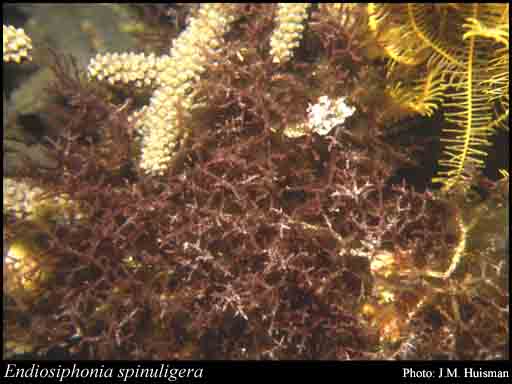- Reference
- Mar.Benth.Fl.S.Australia 251 (2003)
- Conservation Code
- Not threatened
- Naturalised Status
- Native to Western Australia
- Name Status
- Current

Scientific Description
Habit and structure. Thallus dark red-brown, 10–30 cm high, cartilaginous, much branched irregularly radially with 1 to several terete axes bearing 3–5 orders of lesser branches progressively shorter, giving a spiny appearance; axes 0.5–2(–3) mm in diameter, grading to short spinous ultimate branches 1–3 mm long and (100–)200–300 µm in diameter; trichoblasts rhodoplastic, not conspicuous on dried specimens; upper branches usually covered with non-geniculate coralline algae. Holdfast of coarse branching fibres, 1–3 cm across; epilithic. Structure. Apical cell elongate, 8–10 µm in diameter; growth monopodial, trichoblasts developed close to apices, followed by 4 pericentral cells, conspicuous in transverse section and with the basal trichoblast cell enlarged and interposed in the ring of pericentral cells. Trichoblasts 0.5–1.5 mm long, caducous, with 4–9 branches 1–2 cells apart, spirally arranged, lower cells where branched 8–12 µm in diameter and L/D 1–2, unbranched ends with 2–4 small basal cells then increasing suddenly to 12–22 µm in diameter and L/D 5–10(–20). Cortication commencing close to apices, becoming extensive, with the pericentral cells remaining clear in section, surrounded by smaller cortical cells; epidermal cells mostly 10–15 µm in diameter and L/D 2–3, often rosette like over larger inner cells. Lateral branches developed from trichoblasts. Cells multinucleate; rhodoplasts discoid, becoming chained in larger cells.
Reproduction. Gametophytes dioecious. Procarps developed on basal segments (becoming polysiphonous) of trichoblasts or at the base of their branches. Carposporophytes with a basal fusion cell and compact, branched, gonimoblast with clavate terminal carposporangia 16–35 µm in diameter. Cystocarps sessile, ovoid to slightly urceolate, 0.7–1 mm in diameter, with a short neck; pericarp ostiolate, with about 12 erect filaments, each cell cutting off 2 isodiametric outer cells with 1–2 layers of cortical cells. Spermatangia cover the basal part of trichoblasts, with protruding monosiphonous filaments, fertile parts 300–800 µm long and 50–90 µm in diameter, borne on monosiphonous pedicels. Tetrasporangia in branched polysiphonous branches developed from trichoblasts, on monosiphonous pedicels and with apices producing unbranched monosiphonous filaments on each segment, fertile parts 0.5–1 mm long and 100–140 µm in diameter; tetrasporangia spirally arranged, bulging the segments, 60–110 µm in diameter, with 2–3 cover cells.
Distribution.N and W Australia, south to Thistle I.,S. Aust., and from Lord Howe and Norfolk Islands. New Guinea, Borneo, Philippines and the Marshall I.
[After Womersley, Mar. Benthic Fl. Southern Australia IIID: 251–253 (2003)]
Distribution
- IBRA Regions
- Geraldton Sandplains.
- IBRA Subregions
- Geraldton Hills.
- IMCRA Regions
- Abrolhos Islands, Central West Coast, Leeuwin-Naturaliste.
- Local Government Areas (LGAs)
- Augusta Margaret River, Cockburn, Greater Geraldton, Irwin, Rockingham.